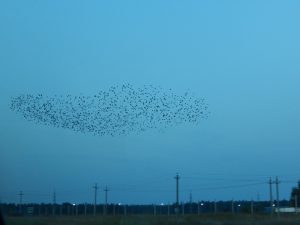If you have ever seen a murmuration of birds, you will remember it. It is such a wondrous sight that it will stay imprinted on your brain forever.
Table of Contents
What is a murmuration?
A murmuration is a flock of birds that fly in a formation of ever-changing patterns; often tens of thousands at a time.
Starlings are the most common example; they perform daredevil aerial displays above their chosen roosting spot.
The word murmuration is thought to come from the whisper-quiet sound that their wings make as they fly on high; murmur – murmur – murmur.
Which birds murmurate
Starlings are the first birds that spring to mind when you mention murmuration. Most other birds share many traits but exhibit flock behaviour. Starlings are putting on a show; the others fly in a formation for a purpose, usually to travel long distances for migration.
Tree swallows – As summer hits Florida, tree swallows prepare to head north, in their millions. Their parting shot is the most spectacular, seemingly choreographed, performance.
They fill the sky, and just as if someone fired a starting gun, they dive toward the ground. The swallows rise in a funnel formation, creating smooth waves in the air.
It lasts 10 – 30 minutes, depending on how many take part.
The flamingo relies on a large flock to exist; they have so few suitable habitats that they need close social contact with their own kind. They feed and breed together, then perform a dancing ritual for hundreds in the hope of impressing one suitable female.
Geese and swans are large-bodied birds that fly in formation to migrate. Thought to be the most energy-efficient way as each bird takes it, in turn, to fly in the slipstream of the one in front.
They have designated meeting points on their journey, usually near wetlands and estuaries. Here they rest and eat together before continuing on their way.
Plovers and dunlins are shorebirds that fly in large groups. Their rapid reactions are almost as impressive as the starlings. They fly very close to one another yet remain in formation and manage to turn on a sixpence.

When is it best to see a starling murmuration?
With a little knowledge, it is possible to be in the right place at the right time to see a murmuration with your own eyes.
The time of year – When the breeding season has ended, the young have flown the nests, adult starlings select a safe space to spend the cold nights. Autumn roosting usually occurs in November but has happened as early as September.
The time of day – Just before dusk, small clusters of birds begin gathering together to form one large group. They join from all directions and instinctively know the choreography. Thousands of birds join until the sky appears black with the floating dance troupe. Their hypnotising display continues for around 30-minutes; the starlings disperse to their roosts and settle in for the night.
Whereabouts – The evening sky above their roosting site is where the wondrous spectacle takes place.
There are various RSPB sites dotted around the UK where your chances of seeing bird murmurate are increased. StarlingsUK website posts regular sightings to keep their readership up-to-date.
- West Brighton Pier – Sussex
The derelict remains of the once-proud pier are now a prime roosting area for starlings. It attracts a regular audience as the sunsets. The sight of 40,000 birds taking flight is breath-taking.
- Aberystwyth – Ceredigion
The Welsh seaside resort boasts another pier that starlings favour. Upwards of 30,000 put on their aerial display in autumn evenings.
- Gretna Green – Dumfries and Galloway
The acrobatics include up to 50,000 birds on the England/Scotland border.
- Leighton Moss – Lancashire
This is one of the RSPB sites that houses around 50,000 starlings. The wetland habitat is perfect for roosting, and the sight of the birds emerging from the reeds and grass is one to cherish.
- Ham Wall – Somerset
Ham Wall is one of the largest and most impressive roosts in the country. Visitors flock to see the spectacular scenes in November, where up to 100,000 starlings take part.
How birds murmurate
The easiest way to describe it is to picture a stadium packed with people doing the Mexican Wave. Each person watches the one next to them and reacts to their movement.
Starlings behave similarly; however, they observe the nearest 4 or 5 birds enabling faster reactions, more accurate, and smoother.
Combine this with an inbuilt innate sense to create a rapid chain reaction, resulting in smooth, floating movements that cause a rippling effect across the sky.
Starlings don’t remain in their starting position during the entire display; they interchange places to allow the vulnerable birds on the outer edges to tuck inside.
Final thought
Not many birds murmurate, so when they do, it is a breath-taking sight.
Many of our starlings are migrants from colder parts of Northern Europe. Their numbers are bolstered to eye-watering amounts, making their perfect synchronisation even more impressive.
